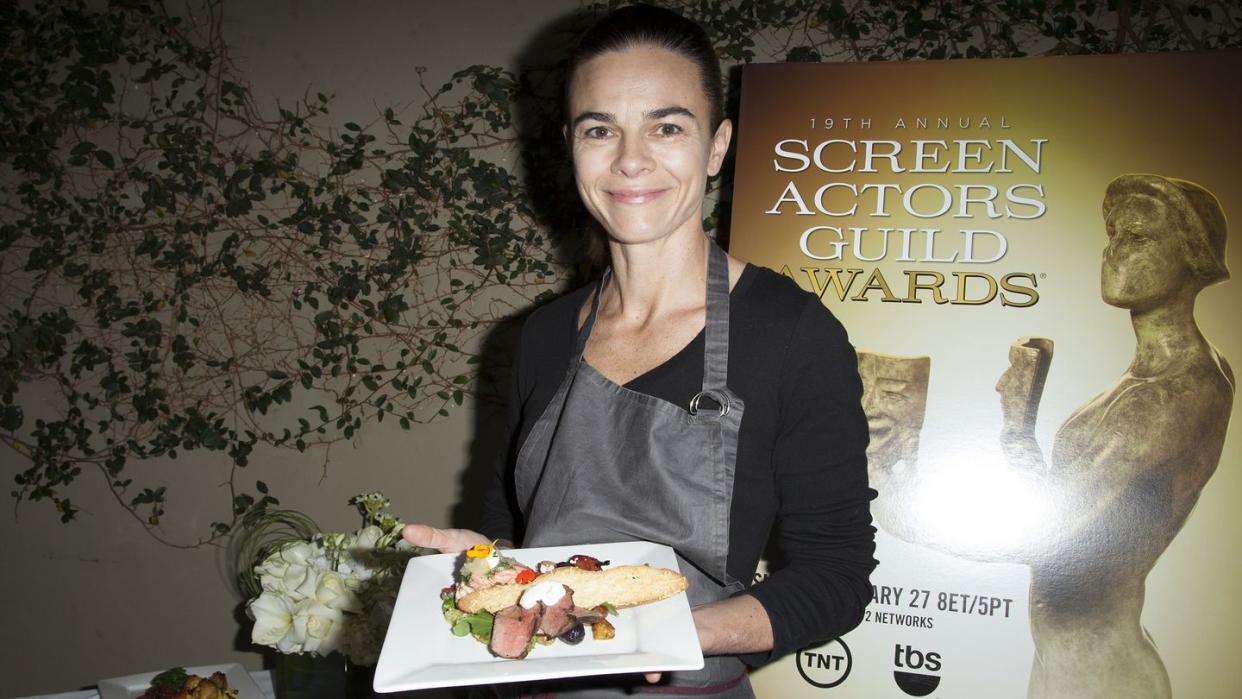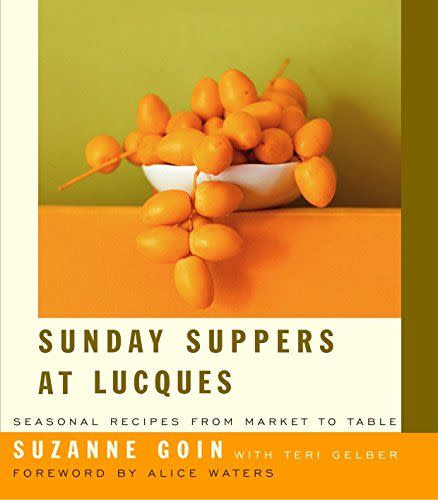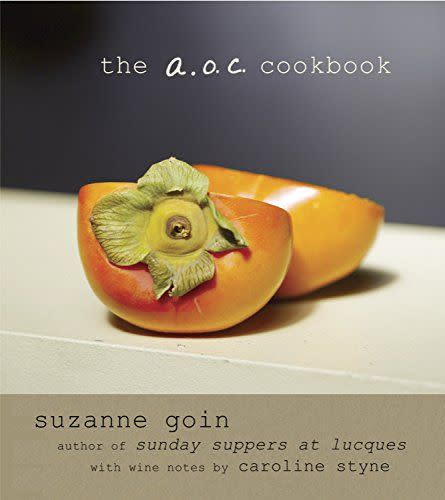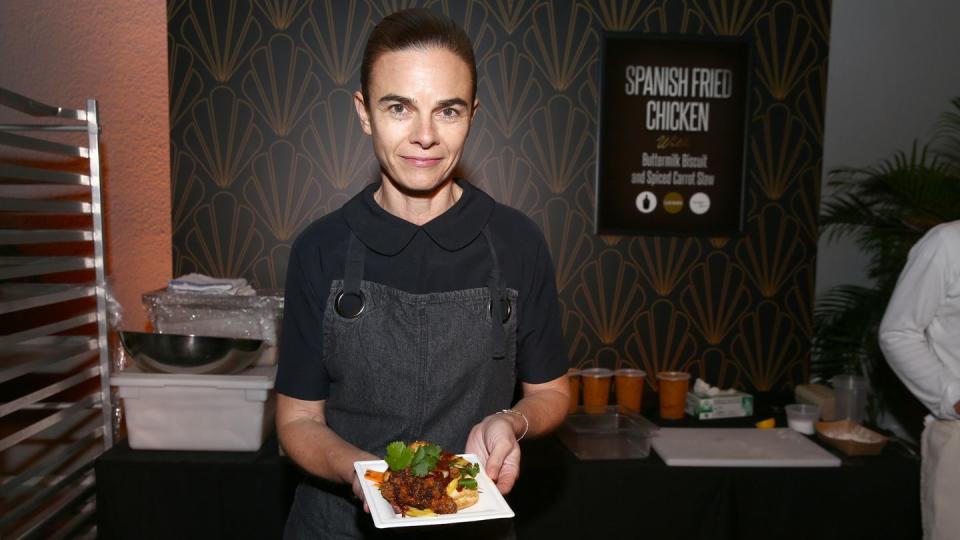How James Beard Award-Winning Chef Suzanne Goin Does Thanksgiving

- Oops!Something went wrong.Please try again later.
"Hearst Magazines and Yahoo may earn commission or revenue on some items through these links."
Candied sweet potatoes, green bean casserole, mashed potatoes, stuffing, and, of course, roasted turkey — these are some of the beloved dishes that even the most culinarily rebellious don’t want to drop from their Thanksgiving menu.
Doing so might break some hearts.
But this doesn’t mean you can’t put a little twist on the classics or add in some new dishes to your menu.
That’s what Suzanne Goin — James Beard Outstanding Chef 2016 and owner of L.A.-based restaurants Lucques, AOC, Tavern, and the Larder — does each year. Goin is the author of two celebrated cookbooks — The A.O.C. Cookbook and Sunday Suppers at Lucques, which won Best Book in the Cooking from a Professional Point of View category at the 2006 James Beard Federation Awards.

Sunday Suppers at Lucques: Seasonal Recipes from Market to Table
amazon.com
$43.37

The A.O.C. Cookbook
amazon.com
$26.46
Goin’s cooking is inspired by a passion for seasonal, locally-grown farmers’ market produce — her dishes almost always star fresh vegetables and fruits. Putting a contemporary spin on French, Spanish, or North African classics is also a hallmark of her cuisine.
So rather than stick to the standard potatoes or green beans, Goin suggests making use of less-expected vegetables to create flavorful sides for your holiday.
“For me, Thanksgiving is so much about the sides,” Goin says. “So you could easily do some grilled white trumpet mushrooms, or roasted honey nut squash, kabocha squash, or acorn squash halves, which you can stuff with sourdough stuffing and mushrooms.”
“Turmeric root vegetables with mint pistou is another side that would work great,” she says.

If you’re feeling really gutsy, she suggests that you can just swap out the turkey altogether.
“My short rib recipe could make a nice alternative to turkey,” she says. “You can also try the slow-roasted pork loin with mustard crumbs or grilled veal chops, both from the Sunday Suppers at Lucques cookbooks.”
As for dessert, Goin skips the apple and pumpkin pie, suggesting some other alternatives that still make use of fall flavors, including “pumpkin” fritters, which are made with kabocha squash to create a pumpkin flavor.
“I recently rediscovered the Roasted Apples with Cinnamon ice cream from the Sunday Suppers book — they are super good and would make a great Thanksgiving dessert,” she says. “Also the apple crostata with Armagnac prunes.”
Cooking a large meal for guests certainly brings its fair share of stress, but it doesn’t come close to the pressure of running five restaurants. Nor does it elicit the pressure of preparing food for fundraising events for Barack and Michelle Obama, which Goin has done on more than one occasion.
But just because Goin can summon nerves of steel in the professional kitchen doesn’t mean she can’t get a tad stressed at times when cooking at home.
The key to avoiding a major freakout? Time management.
“It’s all about planning and prepping in advance,” Goin says. “I always prefer to start early, so I’m not stressed. Many dishes can be prepared a day in advance, like mashed potatoes, sweet potatoes, and Brussels sprouts. You can just heat them up before serving. And stuffing you can make even two days in advance.”
Another way she avoids stressing? Getting a cooking buddy, along with a couple of timeless relaxation hacks.
“Adding in some music, wine and a cooking partner always helps too.”
If you’ve grown a tad tired with your Thanksgiving menu and are in the mood to switch things up this year, try out some of the following Suzanne Goin recipes.
Roasted Kabocha Squash with Dates, Parmesan, and Pepitas
3/4 cup pepitas
1/2 cup plus 1 teaspoon extra- virgin olive oil
2 pounds kabocha squash
1 tablespoon thyme leaves
3 ounces Parmigiano- Reggiano
6 ounces deglet noor dates
2 tablespoons freshly squeezed lemon juice
3 tablespoons sliced flat-leaf parsley
1 bunch dandelion greens, cleaned and dried
Kosher salt and freshly ground black pepper
Preheat the oven to 375°F.
Spread the pepitas on a baking sheet, and toast for about 10 minutes, stirring once or twice, until they smell nutty. Chop them coarsely and then toss with 1 teaspoon olive oil and a pinch of salt.
While the pepitas are toasting, cut the squash in half lengthwise and remove the seeds. Place the squash cut- side down on a cutting board, and use a sharp knife to remove the peel. Slice the squash lengthwise into 1- inch- thick wedges.
When the pepitas are done, turn the oven up to 425°F.
Toss the squash wedges with ¼ cup olive oil, 2 teaspoons salt, some pepper, and the thyme. Place the squash flat on a baking sheet, and roast in the oven for about 30 minutes, until tender when pierced.
Place the Parmigiano- Reggiano flat- side down on a cutting board. Using a chef ’s knife, cut into ¼ - inch- thick slices. Stack the slices, and cut them into 1/4- inch- thick “matchsticks.” Finally, cut those matchsticks into ¼ - inch cubes.
Pit the dates, and slice them thinly lengthwise, being careful not to let them stick together into one big date- ball. Toss the dates in a shallow dish (to prevent the slices from sticking together) with remaining ¼ cup olive oil, the lemon juice, and parsley. Stir in the Parmigiano- Reggiano, and season with salt and pepper. Arrange the warm squash on a platter with the dandelion greens. Spoon the date- Parmigiano relish over the top, and sprinkle the pepitas over salads.
Excerpted from The A.O.C. Cookbook by Suzanne Goin. Copyright © 2013 by Suzanne Goin. Excerpted by permission of Knopf, a division of Random House LLC. All rights reserved.
Turmeric-Spiced Root Vegetables with Kaffir Lime Yogurt and Mint Chutney
9 small or 3 medium carrots, peeled, stems attached if possible
9 small or 3 medium parsnips, peeled, stems attached if possible
6 small or 2 medium turnips
6 small or 2 medium rutabagas, peeled
6 tablespoons extra-virgin olive oil
1 tablespoon thyme leaves
½ teaspoon cumin seeds
¼ teaspoon coriander seeds
3 tablespoons unsalted butter, softened
¼ teaspoon smoked paprika
½ teaspoon ground turmeric
1 cup Greek-style yogurt
1 tablespoon kaffir lime juice, plus ½ teaspoon finely grated zest
2 ounces turnip or mustard greens, cleaned and sliced
1 recipe Mint Chutney (recipe follows)
Kosher salt and freshly ground black pepper
Preheat the oven to 425°F. Slice the carrots and parsnips in half lengthwise. If they are on the bigger side, then slice each half lengthwise again, into long quarters.
Clean the turnips and rutabagas, cut off the tails, and trim the stems, leaving ¼ inch of the stems. Cut small turnips and rutabagas in halves or quarters; if they’re larger, cut them in half and then into ½-inch wedges.
Toss the vegetables with the olive oil, thyme, 1 teaspoon salt, and some freshly ground pepper. Preheat two heavy-duty baking sheets in the oven for 3 to 4 minutes. Carefully remove the baking sheets from the oven, place the vegetables on them, and roast them, tossing a few times, for about 25 minutes, until they are tender and a little caramelized. While the vegetables are roasting, toast the cumin seeds in a small pan over medium-high heat about 2 minutes, until the seeds release their aroma. Using a mortar and pestle, pound the cumin, and transfer it to a small bowl. Repeat with the coriander, and add it, with the softened butter, paprika, and turmeric, to the bowl. Stir to combine well.
Stir the yogurt, lime juice, lime zest, and a heaping ¼ teaspoon salt together in a small bowl. Taste for seasoning.
When the vegetables are done, combine them in one pan and toss in the turnip greens and the turmeric butter. The heat of the roasted vegetables will melt the butter and wilt the greens. Taste for seasoning. Arrange the vegetables on a platter, and top with the kaffir lime yogurt. Spoon the mint chutney over and around the yogurt and vegetables.
Mint Chutney
Using a mortar and pestle, pound the garlic and a pinch of salt to a paste, and transfer to a small bowl. Pound the mint and parsley, and add it to the garlic. Add the olive oil, lemon juice, ¼ teaspoon salt, and ⅛ teaspoon ground pepper, and stir well to combine. Taste for balance and seasoning.
1 small clove garlic
1 cup coarsely chopped mint
¼ cup coarsely chopped flat-leaf parsley
½ cup extra-virgin olive oil
2 tablespoons freshly squeezed lemon juice
Kosher salt and freshly ground black pepper
Excerpted from The A.O.C. Cookbook by Suzanne Goin. Copyright © 2013 by Suzanne Goin. Excerpted by permission of Knopf, a division of Random House LLC. All rights reserved. No part of this excerpt may be reproduced or reprinted without permission in writing from the publisher.
Braised Beef Short Ribs with Potato Purée, Swiss Chard, and Horseradish Cream
Note: Short ribs, like most braised dishes, taste even better the next day. Remember
you will need to marinate them a day before braising.
6 beef short ribs, 14 to 16 ounces each (ask for 3 bone center- cut)
1 tablespoon plus 1 teaspoon thyme leaves, and 4 whole sprigs thyme
1 tablespoon freshly cracked black pepper
3 dozen small pearl onions
1/2 cup extra-virgin olive oil
1 cup diced onion
1/3 cup diced carrot
1/3 cup diced celery
2 bay leaves
2 tablespoons balsamic vinegar
1 cups port
2 cups hearty red wine
6 cups beef or veal stock
4 sprigs flat-leaf parsley
2 bunches Swiss chard, cleaned, center ribs removed
Potato purée (recipe follows)
Horseradish cream (recipe follows)
Kosher salt and freshly ground black pepper
Season the short ribs with 1 tablespoon thyme and the cracked black pepper. Use your hands to coat the meat well. Cover, and refrigerate overnight. Take the short ribs out of the refrigerator an hour before cooking, to come to room temperature. After 30 minutes, season them generously on all sides with salt. When you take the ribs out of the refrigerator, preheat the oven to 425°F. Toss the pearl onions with 2 tablespoons olive oil, 1 teaspoon thyme, 3/4 teaspoon salt, and a pinch of pepper. Spread them on a baking sheet and roast them about 15 minutes, until tender. When they have cooled, slip off the skins with your fingers and set aside. Turn the oven down to 325°F.
When it’s time to cook the short ribs, heat a large sauté pan over high heat for 3 minutes. Pour in 3 tablespoons olive oil, and wait a minute or two, until the pan is very hot and almost smoking. Place the short ribs in the pan, and sear until they are nicely browned on all three meaty sides. Depending on the size of your pan, you might have to sear the meat in batches. Do not crowd the meat or get lazy or rushed at this step; it will take at least 15 minutes. When the ribs are nicely browned, transfer them to a braising pan. They should lie flat, bones standing up, in one layer.
Turn the heat down to medium, and add the onion, carrot, celery, thyme sprigs, and bay leaves. Stir with a wooden spoon, scraping up all the crusty bits in the pan. Cook 6 to 8 minutes, until the vegetables just begin to caramelize. Add the balsamic vinegar, port, and red wine. Turn the heat up to high, and reduce the liquid by half.
Add the stock and bring to a boil. Pour the liquid over the short ribs, scraping any vegetables that have fallen on the ribs back into the liquid. The stock mixture should almost cover the ribs. Tuck the parsley sprigs in and around the meat.
Cover tightly with aluminum foil and a tight-fitting lid if you have one. Braise in the oven for about 3 hours. To check the meat for doneness, remove the lid and foil, being careful of the escaping steam, and pierce a short rib with a paring knife. When the meat is done, it will yield easily to a knife. Taste a piece if you are not sure.
Let the ribs rest 10 minutes in their juices, and then transfer them to a baking sheet.
Turn the oven up to 400°F.
Place the short ribs in the oven for 10 to 15 minutes, to brown.
Strain the broth into a saucepan, pressing down on the vegetables with a ladle to extract all the juices. Skim the fat from the sauce and, if the broth seems thin, reduce it over medium-high heat to thicken slightly. Taste for seasoning.
Heat a large sauté pan over high heat for 2 minutes. Tear the Swiss chard into large pieces. Add 3 tablespoons olive oil to the pan, and stir in the cooked pearl onions. Add half the Swiss chard, and cook a minute or two, stirring the greens in the oil to help them wilt. Add a splash of water and the second half of the greens. Season with a heaping 1/4 teaspoon salt and a pinch of ground black pepper. Cook for a few more minutes, stirring frequently, until the greens are tender.
Place the Swiss chard on a large warm platter, and arrange the short ribs on top. Spoon lots of braising juices over the ribs. Serve the hot potato purée and horseradish cream on the side.
Potato Purée
NOTE: At the restaurant, we pass the mixture through a fine-mesh tamis [twice] using
a rubber spatula. This makes an extremely smooth purée. You can skip this step if you want a more rustic-style potato purée. If you are going to serve the purée immediately, you can hold it in a double boiler or in a warm oven. Otherwise, let the purée cool, then refrigerate it. Reheat the purée gently over medium-low heat, stirring often, and adding more cream if necessary.
1 1/2 pounds russet potatoes
1 1/2 pounds Yukon Gold potatoes
3/4 cup heavy cream
3/4 cup whole milk
8 ounces (2 sticks) unsalted butter, cut into chunks
Kosher salt
Place the potatoes, whole and unpeeled, in a large sauce pot. Add 2 table-spoons salt and fill the pot with cold water. Bring the potatoes to a boil over high heat, turn down the heat to low, and simmer about 45 minutes, until tender. One type of potato may be done before the other, so check doneness and remove one variety first, if necessary.
When the potatoes are cooked through, strain them, and set them aside to cool for 10 minutes or so. Heat the cream and milk together in a small saucepan, then turn off the heat. When the potatoes have cooled, peel them and pass them through a food mill or potato ricer. Put the riced potatoes in a heavy-bottomed pan. Heat them over medium heat a few minutes, stirring continuously with a wooden spoon, to dry them out a little. Add the butter slowly, stirring constantly. Season with 2 1/2 teaspoons salt. When all the butter has been incorporated, slowly stir in the warm cream mixture until you have a smooth purée. Taste for seasoning. Pass the purée through a fine-mesh tamis twice if you like.
Horseradish Cream
3/4 cup crème fraîche
1 tablespoon prepared horseradish
Kosher salt and freshly ground black pepper
Combine the crème fraîche and horseradish in a small bowl. Season with a teaspoon salt and pepper. Taste for balance and seasoning.
Excerpted from The Sunday Suppers at Lucques Cookbook by Suzanne Goin. Copyright © 2005 by Suzanne Goin. Excerpted by permission of Knopf, a division of Random House LLC. All rights reserved.
Spiced “Pumpkin” Fritters with Chocolate Sauce and Candied Pepitas
Makes about 20 fritters
Note: While the fritter batter rises, prepare the chocolate sauce and fried pepitas.
½ kabocha or butternut squash, about 1 pound
1/4 cup whole milk
2 teaspoons dry yeast
3 cups all-purpose flour
1 teaspoon kosher salt
11/2 teaspoons ground cinnamon
½ teaspoon ground ginger
¼ teaspoon ground cardamom
⅛ teaspoon freshly grated nutmeg
⅛ teaspoon ground cloves
4 tablespoons (1/2 stick) unsalted butter, melted, plus a little for the bowl
1 extra-large egg
⅔ cup dark- brown sugar
½ teaspoon pure vanilla extract
1 cup granulated sugar
2 to 3 quarts vegetable oil, for frying
1 recipe Chocolate Sauce (recipe follows)
1 recipe Candied Pepitas (recipe follows)
Preheat the oven to 400°F.
Cut the squash in half lengthwise, and place on a baking sheet cut-side up. (Don’t remove the seeds yet; they give extra flavor.) Cover with foil, and roast for about 1 hour, until very tender. Let cool for 10 minutes, and then scoop out the seeds and discard them.
Purée the warm squash through a ricer or food mill, and measure out ½ cup. (You can reheat any leftover purée, season it with salt, pepper, and butter, and eat it for dinner!) In a large bowl, heat ¼ cup water and the milk to body temperature. Sprinkle yeast evenly across the surface, and allow the yeast to bloom for 10 to 15 minutes.
Whisk the flour, salt, 1/2 teaspoon cinnamon, and the other spices together, and then sprinkle across bloomed yeast. Make a well in the center, and set aside.
Combine the squash purée, butter, egg, brown sugar, and vanilla, and pour into the well of the dry ingredients. Fold together with a rubber spatula until incorporated; be careful not to overmix the batter, or the fritters will be tough. (Some specks of flour are OK.)
Lightly brush a large bowl with melted butter. Scrape batter into the bowl, and flip the batter upside down, so that all sides are covered with a little of the melted butter. Cover with plastic, and allow the batter to rise in a warm, draft-free place for about 1 hour, until doubled in size. Let the batter rest for at least 1 hour in the refrigerator, and then bring it to room temperature when you are ready to fry. (Chilling the batter in the fridge develops the flavor and creates more tender fritters.) Combine 1 cup granulated sugar with the remaining 1 teaspoon cinnamon in a large bowl, and set aside.
Heat the oil to 350°F on a deep-frying thermometer, over medium heat, in a heavy, wide-bottomed pan.
Scoop heaping tablespoons of batter, and use a second spoon to push rounded spoonfuls into the hot oil. Don’t overcrowd the pan; the fritters shouldn’t be touching. Fry for 2 to 3 minutes, until deep golden brown on all sides.
Drain the fritters on paper towels, and pat to remove any excess oil. While they’re still hot, toss fritters in the bowl with cinnamon- sugar mixture. Pile the fritters up on a platter, or divide among six dessert plates. Drizzle with ¾ cup chocolate sauce, sprinkle with candied pepitas, and serve remaining chocolate sauce on the side for dipping.
Chocolate Sauce
Makes about 1 Cup
3 ounces 68% dark chocolate
3 tablespoons sugar
1⁄4 cup good-quality unsweetened cocoa powder
Chop the chocolate into small chunks, and place in a large bowl.
In a saucepan, combine the sugar with 2⁄3 cup water, and bring to a boil. Add the cocoa powder to the boiling water, and whisk to combine. Bring to a boil again, whisking constantly, and then immediately pour the water over the chopped chocolate, and let sit for 1 minute to melt the chocolate. Whisk together until combined, working from the inside out, to emulsify the mixture. Cool to room temperature.
Candied Pepitas
1⁄4 teaspoon cumin seeds
2 teaspoons unsalted butter
1⁄2 cup raw pumpkin seeds
1 tablespoon sugar
Generous pinch each of kosher salt, ground cinnamon, freshly grated nutmeg, and ground cloves
1 teaspoon honey
Toast the cumin seeds in a small pan over medium heat for 2 to 3 minutes, until the seeds release their aroma and are lightly browned. Pound them coarsely in a mortar.
Melt the butter in the cumin pan over medium heat. Add the pumpkin seeds and sugar, then sprinkle the salt and spices over them. Toss the pumpkin seeds to coat them well with the butter, and cook a few minutes, until just after they begin to pop and color slightly.
Turn off the heat, and wait for 30 seconds. Add the honey, tossing well to coat the pumpkin seeds. Spread on a plate, and let them cool.
Excerpted from The A.O.C. Cookbook by Suzanne Goin. Copyright © 2013 by Suzanne Goin. Excerpted by permission of Knopf, a division of Random House LLC. All rights reserved.
Roasted Apples with Calvados and Cinnamon Ice Cream
Roasted Apples
1 vanilla bean
8 tablespoons (1 stick) unsalted butter
6 small baking apples, such as
Pink Lady or Macintosh
2 tablespoons granulated sugar
2 tablespoons brown sugar
1/2 teaspoon ground cinnamon
1/4 a teaspoon freshly grated nutmeg
2 tablespoons Calvados
1/4 teaspoon kosher salt
Preheat the oven to 425°F.
Slice the vanilla bean lengthwise down the center, and use a paring knife to scrape the seeds and pulp into the butter. To make sure not to lose any of the seeds, run your vanilla-coated knife through the butter. Add the vanilla pod to the pan, and cook the butter and vanilla over medium heat 6 to 8 minutes, shaking the pan occasionally, until the butter browns and smells nutty. Remove from the heat, and discard the vanilla pod. Cut the apples in half through the core, and carefully remove the core and seeds with a paring knife (or, for a more dramatic presentation, leave the core and stems intact). Toss the apples in a large bowl with the sugars, brown butter, cinnamon, nutmeg, Calvados, and salt. Arrange the apples, cut side up, in a roasting pan. Top each half with the remaining sugar mixture from the mixing bowl. Bake the apples about 40 minutes, basting them with the pan juices every 10 minutes, until the flesh has pulled away from the skin and the apples are tender and caramelized.
Cinnamon Ice Cream
2 cups whole milk
2 cups heavy cream
2 cinnamon sticks
1/2 teaspoon ground cinnamon
4 extra-large egg yolks
1/2 cup granulated sugar
Makes 1 quart
Place the milk, cream, cinnamon sticks, and ground cinnamon in a medium pot. Bring to a boil over medium heat. Turn off the heat, cover, and let the flavors infuse about 30 minutes.
Bring the mixture back to a boil over medium heat, stirring occasionally. Turn off the heat. Whisk the egg yolks and sugar together in a bowl. Whisk a few tablespoons of the warm cream mixture into the yolks to temper them. Slowly, add another a cup or so of the warm cream, whisking to incorporate. At this point, you can add the rest of the cream mixture in a slow steady stream, whisking constantly.
Pour the mixture back into the pot and return to the stove. Cook the custard over medium heat 6 to 8 minutes, stirring with a rubber spatula, scraping the bottom and sides of the pan. The custard will thicken, and when it’s done will coat the back of the spatula. Strain it and chill at least 2 hours in the refrigerator. The base should be very cold before you churn it. Process in an ice cream maker according to the manufacturer’s instructions.
Excerpted from Sunday Suppers at Lucques by Suzanne Goin. Copyright © 2005 by Suzanne Goin. Excerpted by permission of Knopf, a division of Random House LLC. All rights reserved.
Tracy Chabala's personal essays and journalism have appeared in the Los Angeles Times, the LA Weekly, VICE, Motherboard, Salon, and other publications. She holds an MFA in Professional Writing from the University of Southern California. Twitter: @TracyAChabala
Get Shondaland directly in your inbox: SUBSCRIBE TODAY
You Might Also Like

